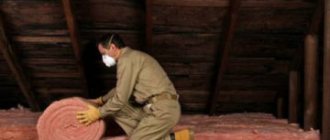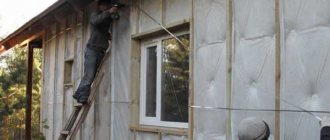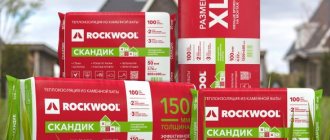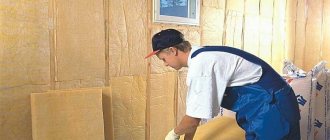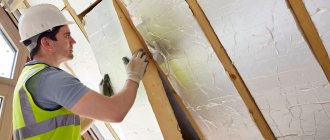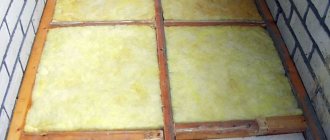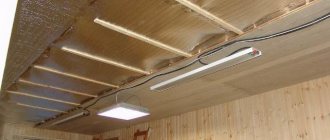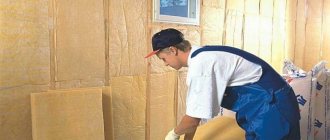The weather conditions of a short summer period and a long frosty winter suggest the use of additional thermal insulation during the construction of houses. The international construction market is saturated with various insulation materials, but experts recommend using mineral wool as an economical and effective material. Thermal insulation for finishing the foundation, walls or ceilings differs in its characteristics, so let’s look at which mineral wool is better for the ceiling and what insulation methods exist.
Characteristics of mineral wool
Thanks to its technical properties and easy-to-install dimensions, mineral wool has gained popularity not only among professional builders, but also among owners of private houses and apartments interested in insulating premises.
To maintain heat in apartments, almost all qualities of the material are important:
- environmental friendliness; fire resistance; water resistance; sound insulation properties; resistance to wear and rot.
Rolled mineral wool is the best option for ceiling insulation
The optimal set of useful properties is provided by the unique structure of mineral wool, which has no analogues among industrial thermal insulation products.
The only negative concerns the high degree of moisture absorption, but with proper installation of the panels it loses its relevance. To protect against condensation, rolls and mats are covered with a layer of waterproofing - thin impermeable foil. In the absence of protective foil, it is compensated for by an additional layer of polyethylene film and glassine, which acts as a vapor barrier.
When using foiled mineral wool, you can save on the purchase of waterproofing
Among the wide range of products, it is difficult to determine which mineral wool to choose for the ceiling in an apartment, and which for thermal insulation of a private house.
In fact, the easiest way to focus is on the type of packaging and layer thickness. Typically, products are produced in the form of mats, rolls (rolled slabs) and cylinders. The latter type is used for insulation of ventilation pipes, mats are used for external thermal insulation of foundations and floors in basements, so rolls are more suitable for housing.
Insulation with a thickness of 50-100 mm is suitable for apartments in multi-storey buildings, but for cottages thicker and denser rolls are needed - 150-200 mm in thickness, since there are most often unheated attic spaces above the living rooms.
Cottage: insulating the attic
Given: above our heads we have rafters and a roof laid on them. How to properly insulate a ceiling under a cold roof?
Let's see what the attic insulation will look like.
Waterproofing
A layer of waterproofing must be present directly under the roof. The reason is that in winter moisture will condense on the cold inner surface of the roof. The waterproofing layer in this case will create a barrier that will prevent water from getting onto wooden structures and causing them to rot.
Mineral wool itself does not rot; however, the thermal insulation qualities of wet wool are much worse.
It is highly advisable to leave a gap of 2 - 3 centimeters between the waterproofing and the roof itself for ventilation. The condensation will need to drain and evaporate; For this you need at least some air movement.
There are now many materials available for waterproofing; the most reliable and durable of them is ordinary polyethylene film. It is absolutely impermeable to moisture and has a service life of at least 50 years.
The waterproofing strips are attached with an overlap, with an overlap of 10 centimeters. The lower strips are attached first, the upper ones overlap them so that water cannot flow under the material (see Insulation for the ceiling - types of insulation, methods of attaching to the ceiling).
Laying wool
On sale you can find mineral wool packaged in two main ways:
Mineral wool with a thickness of 50 millimeters or less is sold in rolls. They are unwound, the wool is cut in place with an ordinary knife and attached between the rafters.
The method of fastening depends on the density of the wool and the distance between the rafters: it can simply be placed apart; can be fixed to the rafters with a stapler; as an option, a sheathing of slats can be assembled from below, under a layer of cotton wool, or a mesh of nylon rope can simply be stretched.
Mineral wool 10 centimeters or more thick is sold in mats and placed spaced between the rafters. At the same time, sufficient rigidity is ensured in order to retain the thermal insulation until the filing (see Insulating the ceiling from the inside: choosing a material and the main stages of work).
The ideal option is when the distance between the beams is equal to the width of the thermal insulation mat.
Vapor barrier
A vapor barrier layer is needed to ensure that the inevitable indoor humidity does not affect the thermal insulation properties of mineral wool.
Ideally, a vapor barrier should have two contradictory properties:
- Retain water vapor;
- Let air through, providing ventilation of the heat-insulating layer.
A popular and cheap vapor barrier material is glassine; It is usually attached to the rafter system with a conventional stapler. It is advisable to additionally glue the strips of material with double-sided tape to ensure maximum tightness of the layer.
There are now a lot of materials for vapor barrier. A film with a foil layer will further reduce heat loss due to radiation.
Brief overview of manufacturers
Nowadays it is easy to purchase products for any construction purpose, and mineral wool for the ceiling is no exception. Most likely, the supermarket will offer you several options that differ little from each other.
Brands known for excellent product quality and leaders in the thermal insulation products market:
- Knauf (Knauf - an international company); Isover (Isover - an international group); TechnoNIKOL (Russian corporation); Ursa (Ursa - a subsidiary of the Spanish group Uralita); Rockwool (an international group of companies headquartered in Denmark).
For insulating ceilings, both stone wool, produced on the basis of basalt rocks, and glass wool, which is produced after processing quartz sand and glass production waste, are suitable.
Diagram of one of the options for insulating the attic floor
How to properly insulate a ceiling
The installation of ceiling tiles should be given special attention, because improper installation of mineral wool on the ceiling will result in the loss of its thermal insulation properties - during the first year the characteristics deteriorate by about 40%.
In addition to insulation, you will need tools and fasteners:
- self-tapping screws, plastic fasteners, nails; a set of counter slats; a metal profile with hangers; a screwdriver; a tape measure, a hammer; a stationery knife with a thin blade; glue for insulation.
The correct calculation of the material will be made right in the store, if you provide data on the working surface area.
Laying insulation on a metal suspended ceiling profile
Properties and application features of the material
The main property that determines the effectiveness of a particular insulation is the thermal conductivity coefficient.
It characterizes the heat loss occurring through a layer of material 1 m thick in an area of 1 m2 for 1 hour with a temperature difference on opposite surfaces of 10 ° C.
For various forms of mineral wool, this figure is 0.03 – 0.045 W/(m*K).
A distinctive feature of fiber insulation is the dependence of their thermal insulation properties on moisture content.
When wet, droplets of water envelop the fibers and gradually penetrate into the volumetric structure, gradually displacing air from there.
An increase in the amount of water inside, between the fibers, leads to a sharp drop in thermal insulation characteristics. The situation is further aggravated by the fact that water that gets inside is extremely difficult to remove outside.
The insulation can absorb up to 70% of its mass in water. Naturally, under these conditions, the efficiency of its work will tend to zero.
Despite the criticality of getting wet, the scope of application of mineral wool is extremely wide. When building a house, its use is possible almost everywhere where direct contact with water is excluded:
- Hollow walls (frame and brick, made using well masonry technology);
- External surface of wooden or brick walls;
- Internal partitions;
- Floors;
- Interfloor ceilings;
- Roof.
Instructions for internal thermal insulation
Internal insulation is most often carried out in city apartments. Pay attention to how to attach mineral wool to the ceiling: a mandatory step is the construction of the frame.
Main stages of work:
Creating metal profile lathing for suspended ceilings or boards. The profile has certain standards, and for a wooden frame, boards with a cross section of 30 x 100 mm or 40 x 200 mm are suitable - the heavier the thermal insulation boards, the more powerful the frame.
The profile slats are attached to the ceiling with dowels on hangers, the distance between them is approximately 55-60 cm (the most convenient for laying slabs). Insulation of the ceiling in a private house on a wooden sheathing. Attaching waterproofing (using simple mineral wool). The thick film is cut into strips slightly wider than the intervals between the slats - 65-70 cm.
For fixing to a wooden base, thin counter-battens and nails are used, and screws are used to a metal profile. Laying insulation. Mineral wool is fixed in two ways: with a construction stapler or using special glue. At the same time, a vapor barrier layer, which is the top one, is also installed.
Glassine is considered a good vapor barrier; mineral wool glue is suitable for fixing it. One of the methods of laying thermal insulation slabs is along beams. Strengthening the thermal insulation with transverse slats. The result of the work should be a stable, durable three-layer “pie” without gaps between the plates.
On the bottom side, sheets of plasterboard are attached to the profile, completely covering the thermal insulation pad. The result is an insulated suspended structure, which is subsequently equipped with lamps and decorated in accordance with the design project.
Which mineral wool is better for the ceiling?
When choosing, pay attention to the thickness of the mineral wool for insulating the ceiling. To soundproof the ceiling in an apartment, fire-resistant mineral wool 5 cm thick is nailed to the top.
The ceilings of a cottage or private house are covered with mineral wool at least 15 cm thick. An important indicator is the density of mineral wool. The higher it is, the greater the load the building material can withstand. The optimal density is considered to be 80 kg/cubic meter. m.
Mineral wool is available for sale in tiles and rolls. They buy slabs for internal insulation because they are made to standard sizes and are more convenient to cover the ceiling surface with. When insulating from the attic side, roll mineral wool is used.
Mineral foil wool is also sold on the construction market. It costs more than usual. However, when attaching mineral wool to the ceiling, do not additionally buy waterproofing building materials - foil-coated polyethylene foam or dense polyethylene film.
Ceilings are covered with mineral wool in the attic or indoors. This is discussed in more detail below in the article.
Attention! Ceilings on the attic side are often insulated with basalt wool. And mineral wool mats are installed inside a cottage or private household. They are lighter in weight, so they can be easily and quickly installed on the ceiling.
Stages of external thermal insulation
For external insulation, the presence of an attic non-residential space is required. The process of laying mineral wool is simpler than during interior work and takes less time, because the mineral wool is attached not to the ceiling, but to the floor.
We follow the following procedure:
We cover the entire area of the attic floor with a layer of glassine, laying the sheets overlapping (10-15 cm is enough). We glue the joints or reinforce them with tape.
The effectiveness of the vapor barrier layer will increase several times if it is reinforced with sheets of 5-centimeter polystyrene foam. We lay rolled mineral wool of the standard 150-200 mm. We make sure that there are no gaps between the plates. If the rolls are covered with foil on one side, the insulation process ends here.
The sheets must be positioned so that the foil is on top. We fix the material with slats; it is not recommended to pierce the thermal insulation directly with nails. We stretch a thick film over simple mineral wool (without foil) (you can use greenhouse film) and fix it with slats. We glue all joints and joints with double-sided or regular tape.
External insulation with mineral wool - laying slabs on the attic floor
A floor made of any available material is laid on top: chipboards, plywood, boards. Sometimes the roof also requires additional insulation. Thermal insulation is carried out according to the same principle as the option for apartments, but with one caveat - instead of a powerful frame, a light sheathing of counter-battens is sufficient.
Combined method of insulation
Thermal insulation of the ceiling on both sides in residential buildings is done extremely rarely; it is usually necessary for equipping rooms in which heat is maintained for a long time: steam rooms, saunas, baths. Sometimes double insulation is important in houses with irregular or stove heating. You already know which thermal insulation to choose or how to fix mineral wool on the ceiling; all that remains is to choose the order of work: you can start with both external and internal insulation.
The results of work on insulating residential premises are immediately noticeable - the house becomes warm, dry and cozy.
The ceiling is one of the most important attributes of a room. Its appearance should not only be attractive, but also have protective functions.
The insulation is attached to the ceiling using various types of means and materials. The main and most used of them is considered to be mineral wool; it is the one that has the most advantages in its use. In the modern world, the ceiling plays not only a decorative role, but also performs a number of mandatory functions, such as:
- Noise. Protective. Thermal insulation.
Options for insulating the ceiling with mineral wool
There are two insulation options:
- Internal insulation.
Most often it is performed in cases where it is not possible to insulate the attic or when the ceilings of the room are sufficiently high. Depending on the roof structure, temperature changes and the type of mineral wool, the thickness of the insulation will be from 15 to 40 cm.
- Attic insulation
This method is much more convenient, allows you to use cheaper insulation and will help maintain the height of the room.
Mineral wool
Mineral wool is a fiber made from textiles.
It can be purchased in the form of rolls or blocks. The one made in the form of a path has greater thermal insulation. It not only has better performance properties, but it is also much easier to work with.
How to attach insulation to the ceiling using mineral wool? Let's look into this issue.
Thanks to cotton wool, it becomes possible not only to insulate, but also to protect the room from excessive noise, as it has excellent sound insulation properties. The installation itself is carried out using dowels with a wide head. Additional means for more durable fastening can be self-tapping screws and self-adhesive tapes.
Mineral wool on the ceiling
The installation instructions include the following work steps:
Measurements are taken from the ceiling on which installation is planned. Preparation of the slabs. They must correspond to the measurements taken and be completely identical. Holes for dowels are drilled in the ceiling. In this case, it is better to use plastic ones. With their help, metal profiles are installed on the base. Mineral insulation is applied to the profiles. After applying mineral wool, the entire structure is secured with dowels. Sheets are laid on top.
They also need to be secured as best as possible. This can be done using wooden slats and nails that resemble mushrooms in appearance. They received this name because of their wide cap on top. During installation, cracks and openings may remain, which it is advisable to fill with polyurethane foam.
Fastening mineral wool insulation has its advantages, such as:
- This material has high environmental parameters. It is hypoallergenic. Durable in use, thanks to the high quality of the products used. It is not subject to deformation. It is a fireproof material, which expands the range of its use. Application is possible even in bathhouses or saunas. High percentage of vapor permeability.
One of the important aspects in installation is that during installation the material itself must be placed tightly, but in no case be subject to deformation. Otherwise, it may lose its performance properties.
For a longer period of operation, it is advisable to coat the surface with an antifungal agent upon completion of installation work. This will allow further dust collection.
Features of installation of mineral wool
Modern types of mineral wool are completely safe and do not emit any harmful substances during operation. But during installation you must follow certain rules.
With any type of mineral wool, microscopic fibers are separated during installation. They can get into a person's eyes and lungs, and penetrate under clothing. Glass wool is especially harmful to health, since the smallest glass needles do not dissolve in the lungs and can provoke the development of complex pulmonary diseases.
Therefore, it is recommended to work with mineral wool in a closed suit, gloves, goggles and a respirator. At the end of the work, you need to take a shower, throw away your clothes or wash them thoroughly.
Polyethylene foam and polyplex
In addition to mineral wool, attaching insulation to the ceiling can be done using other materials, such as:
Foil polyethylene foam.
In appearance, it is polyethylene foamed in a special way and subsequently glued to aluminum foil. You can find a similar look in rolls. Their width is standard and reaches one meter, and the thickness can vary from one to twenty centimeters.
It can be used either independently or used in combination with mineral wool to improve the thermal barrier. Also, this combination makes it possible to protect against various carcinogens that can appear due to the use of cotton wool.
Polyplex is the result of extrusion of polystyrene foam.
It can be purchased in the form of sheets measuring 60*120 centimeters. The thickness can vary: from one to twenty centimeters. Among the advantages, one can highlight the increased density, due to which it has found its use not only in the form of insulation, but also as a rough base for putty.
From the above we can conclude that both types have their advantages and their installation can be done independently. The polyethylene foam is fastened by gluing it with special glue or using dowels, widely used in construction. The polyplex is attached with dowels or holders that look like the letter P.
Advantages
Mineral wool attracts craftsmen with its advantages. Let's dwell on the basic advantages of the material.
- Convenience. When used and installed, mineral wool is very convenient. The material is produced in the format of plates and rolls. They are easy to unfold, cut, fasten, and also make indentations for the passage of communications.
- Availability. The minimum cost of insulation also largely determined its demand on the market. The material is economical, but at the same time remains reliable, of high quality, and helps to achieve results.
- Increased fire resistance. During repairs and finishing, the possibility of fire should be considered. It is recommended to give preference to safe materials that do not support combustion. Mineral wool attracts with its fire resistance. In addition, it prevents the spread of fire throughout the room.
- Density. Thanks to its increased density and fibrous structure, the material guarantees the maintenance of an excellent microclimate. In addition, decent sound insulation is provided.
- Minimum weight. It is especially convenient to work with such insulation: the weight is relatively light, so even insulating the ceiling does not involve large physical costs.
- Durability. Mineral wool retains its properties, structure well, and performs all functions. Of great importance here is the fact that the material is not afraid of all kinds of pests.
- Ecological cleanliness. The material is completely safe. It is important to remember that mineral wool has structural features: small particles can enter the respiratory tract and crumble. Therefore, when working with insulation, it is necessary to take precautions and use protective equipment.
- Strength. Mineral wool can cope with negative mechanical influences and serious loads.
- Optimal vapor permeability. This excellent property has become universal: excessive evaporation is prevented in cold winters, and protection against overheating is provided in summer.
- No pungent odor. You can safely use insulation in residential areas.
It is very important to choose the right size of mineral wool
Foam plastic and expanded clay
Polystyrene foam in appearance resembles foamed plastic material with a cellular structure. It is usually produced in size meter by meter and is used not only as internal, but also external insulation. Its thickness can vary from twenty to one hundred centimeters.
This depends on the type of finishing required. Can be used as a base for ceiling putty. Another feature is its ability to level surfaces.
Polystyrene foam is not only convenient to use, it also has a number of advantages, such as:
- Has proven itself as a universal remedy. Quite low cost. Based on this factor, this makes it more accessible to the population. Durable in use. Provides a very high level of reliability of room protection. Has good thermal insulation.
The main component of expanded clay is clay, from which it is subsequently made. It looks like balls and is easy to insulate a room with. The principle of working with it is to backfill it in the attic, so it is only relevant in private homes.
When insulating the roof of a house with expanded clay, you can use these useful instructions to help you carry out the installation correctly. These tips include specific actions such as:
- The work process should begin directly with the installation of waterproofing. The choice of means for it is quite large, and all of them are ideal for carrying out this process. It is necessary to cover the rafters and chimney pipe prematurely. For a better vapor barrier effect, a layer of clay should be laid on it. Expanded clay is laid out in layers of at least 15 cm. Thus, thermal insulation is significantly increased .
Expanded clay has a number of advantages, such as:
- It is one of the materials that does not decompose over time. Others can harbor various insects and small rodents. Expanded clay completely eliminates this possibility. It is considered fire-resistant and fireproof. It has good sound insulation. It is waterproof. It has frost resistance, which is very important in winter. It has high heat transfer. It is quite low in cost due to the materials from which it is made. It is used not only for ceilings . It can also be used for foundations and walls.
Insulation from above
Insulation implies various methods of attaching insulation. Today two types are known:
The upper one provides for insulation from the attic of the house, which is quite relevant for private houses. The process includes a sequence of actions such as:
- The first stage is the filing of the beams. Laying of insulation. After which the insulation material itself is directly laid. The final step is the cladding. You can use a board for it. This is done to allow free movement around the perimeter of the attic.
The advantage is that you can use any type of insulation, even in bulk form, such as expanded clay. An important feature that you should pay attention to when laying is that during the process itself it is very important not to leave empty space.
Regardless of the method, for installation you will need tools such as:
- Knife or hacksaw. Nails. Various screws. Hammer. Grinder. Electric drill. Stapler designed specifically for construction work. Polyurethane foam. Profiles. Screwdriver. Self-tapping screws. Dowels.
Insulation from below
This type involves the process itself directly from the bottom of the ceiling itself. Materials made in rolls or beams are ideal for it.
This method is considered more difficult and labor-intensive. The process itself includes the following stages of work:
- It is necessary to make the fastening using hemming. If this was not possible, you can build up beams on which the installation will be carried out in the future. If it is done using foam plastic, then the process itself is greatly simplified. It can simply be glued to the ceiling. But after this, to increase reliability, it should be additionally secured with dowels intended for these types of work. After the installation process, the ceiling itself, if its condition requires it, can be decorated by painting or using putty.
Thus, you can carry out the fastening with your own hands. The main criterion is the presence of either a suspended frame or specially made fastenings.
If the ceiling height is low, it is better to opt for foil-coated polyethylene foam. The profiles on which they will subsequently be attached can be made of metal or wood. After insulation is completed, if desired, the ceiling can be decorated in various ways, the main ones being painting or installing a stretch ceiling.
Today there is a huge selection of insulation materials that can not only retain heat in your home, but also provide good sound insulation, which is quite important in multi-story panel or brick houses.
- Date: 02/05/2015 Comments: Rating: 15
Warmth and comfort in the home are one of the first tasks that need to be solved for a comfortable life and preservation of health. In the modern world, where the daily rise in price of energy resources is by no means new, the issue of insulating living quarters is acute.
Scheme of insulation and soundproofing of a wooden ceiling.
To ensure the safety of heat from below, “warm floors” are used; to prevent it from escaping through walls and windows, plastic structures are used.
But it is extremely important to pay attention to heat loss through the ceiling. This is due to the fact that more than 30% of all heat is concentrated at the top of the room. If adequate thermal insulation is not maintained, this will inevitably lead to condensation settling, an increase in the amount of moisture and, as a result, the formation of mold.
How to avoid this, you ask? Is it possible to insulate a ceiling with your own hands?
Of course. In addition, it is quite simple to do, without spending a large amount of effort and material investments. You just need to properly understand the question of how to attach the insulation to the ceiling?
Before considering the issue of attaching insulation to the ceiling, you should pay attention to such an important aspect as the types of insulation. What is the material with which you will insulate your ceiling? After all, only after deciding on this issue, you can purchase it and start mounting it.
Technology of internal insulation of floors in the house
Knowing how to properly insulate the ceiling in a house with mineral wool helps to properly perform thermal insulation and successfully retain heat in the coldest weather. If you plan to insulate the ceiling surface in your own home with your own hands, then it is better to use mineral wool made in the form of slabs.
The use of insulation together with a metal frame and sheathing made of plasterboard sheets makes it possible to create an insurmountable barrier to heat flows rushing upward to the ceiling.
Thermal insulation work is carried out in several stages:
Self-tapping screws made of hardened steel are ideal for cladding, as they are highly durable and can withstand significant loads.
Mineral wool cannot be compressed, since its ability to retain heat lies in the fact that the air bubbles hidden inside it interfere with the heat exchange between the attic and the rooms.
